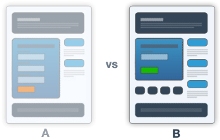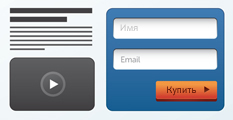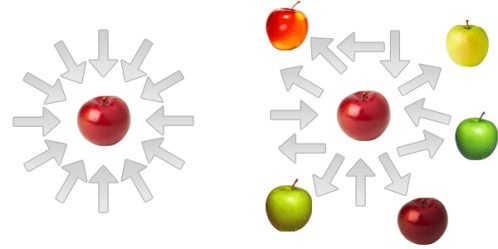Steps to optimize capture pages

At the moment, the Internet marketing market is undergoing a number of turning points - today on the Internet you can buy anything, while lying on a cozy sofa at home. For companies providing goods and services that have many competitors in their segment, the search for new customers in traditional ways is not so effective. Convenience and ease in purchasing goods play an important role in our age for an ordinary person. One of such comfortable means is search and purchase through the Internet. And now everything is done in order to make it as fast and user-friendly as possible.
The majority of Internet users encounter such a problem: when they need to buy something on the network, they go to sites that have a large amount of content and just a huge list of different goods and services, most of which he doesn’t need at all ... As a result, his the focus is not on what he was looking for, but on a pile of things that separate him from the purchase: a large number of menus, different concepts and wording, other services, third-party advertising banners, incomprehensible and supposedly “cool, attracting izayn ”etc.
So, what am I leading to ...
In this article I want to share some recommendations on how to DO NOT interfere with the user becoming a client, it will also be useful for those involved in traffic arbitrage and know firsthand what is affiliate marketing and traffic monetization on the CPA model ( Cost Per Action ) .
So, let's go! You have a business, but you need to build an effective strategy to attract users to the site with a specific product or service. Below I will give specific tips on how to make a product page, thanks to which there will be a noticeable increase in the conversion of visitors into leads ( potential customers ).
Here are some simple step-by-step strategies that allow both experienced and novice users to avoid major mistakes in the development of landing pages ( contact capture page, Landing Page, landing page, landing page ), and also increase conversion ( target action, CTA, attitude of accomplished actions, to clicks (expressed in%) ) already available:
')

Step 1. Separate page under the source
Using a unique page for each type of traffic will allow you to identify the best source for this product / service.
For e-mail traffic, for example, the page will contain a much larger amount of information about the proposed product. The landing page will be fundamentally different from the one created for another traffic source.
Step 2. A / B - testing landing pages
 Your landing page can always be better. Just like the plant - landing page, you need constant attention to achieve the best results.
Your landing page can always be better. Just like the plant - landing page, you need constant attention to achieve the best results.A / B testing is the use of different landing options at the same time, the purpose of which is to identify the page with the highest conversion ability.
Use this method constantly. Experiment with the design, reformulate the headings, the text. Conversion analysis will show which of the pages should be left.
Step 3. Request text = page title
If the main title of your landing page or its context does not match the user's search query, it is likely that it will instantly leave the page. The same situation will occur in the case when the context of the landing page does not match the user's expectations or does not correspond to the image created by the banner or advertising title that led him to the target.
Matching the page with user requests and expectations is an inevitable path to conversion.
Step 4. Context of use
Use on the page a photo / video of your product or service, as well as use it in real life.
They say that it is better to see once than hear a hundred times. A more complete picture of the product create visual images. It is necessary to influence the user's emotions in order to influence the speed of his decision. When selling a service, draw the result. When selling a product, portray the pleasure or comfort of using it. Add more emotions and images, the visitor should see your product, not read about it.
Step 5. Using a video presentation will increase the conversion
 According to research, using video on a capture page can increase conversion by 80%. By providing users with a passive participation mechanism, you can keep them on your page for a much longer amount of time, respectively, to penetrate the subconsciousness more strongly, thereby influencing the decision.
According to research, using video on a capture page can increase conversion by 80%. By providing users with a passive participation mechanism, you can keep them on your page for a much longer amount of time, respectively, to penetrate the subconsciousness more strongly, thereby influencing the decision.Step 6. Visual attention drawing tricks

Use arrows, unusual colors, direct references in the text, etc., thus accompanying the user to the form of performing the target action.
Step 7. Number of fields VS. Number of conversions
This is a delicate balance:
- you make too many data entry fields, and people are running from the effort to fill them all. Also, taking into account the off-topic fields, or perceiving some too personal — they introduce false data;
- if there are few fields, this in turn affects the quality of leads, there will be a lot of registrations from freebie seekers, and not from future customers.
In this case, A / B testing becomes really useful. Installing several versions of the form and analyzing them will allow you to find a balance.
Step 8. “Brevity is the sister of talent” A.P. Chekhov
Reading detailed descriptions and boring texts drives users away.
Paraphrasing Steve Krug (the author “do not make me think”): throw away 50% of the text, throw out half of the rest.
As short as possible, inform the user what he will receive as a result of the action.
Step 9. The ease of social sharing

Add on Twitter, Facebook, VK ... and other widgets that allow you to share your social audience about your offer with one click. Give an opportunity to users who liked the content on your page, service or product, freely share information about it with friends. This will significantly increase the flow of traffic to your resource.
Step 10. Trust and social demand
 The presence of feedback creates trust. But you do not have to resist the temptation, using the unreal - it is very felt and instantly repels the user.
The presence of feedback creates trust. But you do not have to resist the temptation, using the unreal - it is very felt and instantly repels the user.In addition to those listed above, there is still a huge list of buttons, widgets of social networks, with the help of which you can show how many people who like the resource or follow you. Social movement and the "gregarious" feeling of people will give an increase in the flow of customers.
Do not use images that are publicly available on the Internet, especially those that appear first in the search engine image search. You will demonstrate unreliability. The same goes for stock photos and outdated text messages, reviews or articles.
Step 11. One page - one goal.

To keep the focus on a specific action and increase conversion, do not explicitly mention the presence of any other products of a different focus. For other products or services you can use an individually designed landing page, and separate advertising campaigns for each. An exception may be a product that makes it possible to add small upgrades to the main product as part of an order.
Step 12. Post-conversion marketing
Using the confirmation page for further participation and receiving news about new products, bonuses, events (links and all sorts of options to follow you to other resources) is the right step in creating regular customers.
You need to do more than just “thank you” on your “thank you page”. Begin by adding one additional offer or encourage follow up on your other resources. Having done this, you will be surprised how much additional traffic this simple step will attract.
Do not try to put all the recommendations on the same landing page. Choose the most effective content and presentation for your audience. If you feel that the above recommendations for you at this stage are difficult to implement - contact the professionals.
See live examples of high-conversion lead leads can be found in partner CPA systems. You can analyze individual cases in more detail from the CPA Network.
Experiment! Thanks for attention. Successes!
 May 24, 2012, Ivan Shevelev, CPA Network
May 24, 2012, Ivan Shevelev, CPA NetworkSource: https://habr.com/ru/post/144487/
All Articles